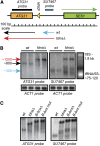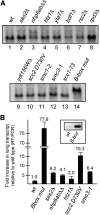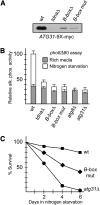Intergenic transcriptional interference is blocked by RNA polymerase III transcription factor TFIIIB in Saccharomyces cerevisiae
- PMID: 24336746
- PMCID: PMC3914616
- DOI: 10.1534/genetics.113.160093
Intergenic transcriptional interference is blocked by RNA polymerase III transcription factor TFIIIB in Saccharomyces cerevisiae
Abstract
The major function of eukaryotic RNA polymerase III is to transcribe transfer RNA, 5S ribosomal RNA, and other small non-protein-coding RNA molecules. Assembly of the RNA polymerase III complex on chromosomal DNA requires the sequential binding of transcription factor complexes TFIIIC and TFIIIB. Recent evidence has suggested that in addition to producing RNA transcripts, chromatin-assembled RNA polymerase III complexes may mediate additional nuclear functions that include chromatin boundary, nucleosome phasing, and general genome organization activities. This study provides evidence of another such "extratranscriptional" activity of assembled RNA polymerase III complexes, which is the ability to block progression of intergenic RNA polymerase II transcription. We demonstrate that the RNA polymerase III complex bound to the tRNA gene upstream of the Saccharomyces cerevisiae ATG31 gene protects the ATG31 promoter against readthrough transcriptional interference from the upstream noncoding intergenic SUT467 transcription unit. This protection is predominately mediated by binding of the TFIIIB complex. When TFIIIB binding to this tRNA gene is weakened, an extended SUT467-ATG31 readthrough transcript is produced, resulting in compromised ATG31 translation. Since the ATG31 gene product is required for autophagy, strains expressing the readthrough transcript exhibit defective autophagy induction and reduced fitness under autophagy-inducing nitrogen starvation conditions. Given the recent discovery of widespread pervasive transcription in all forms of life, protection of neighboring genes from intergenic transcriptional interference may be a key extratranscriptional function of assembled RNA polymerase III complexes and possibly other DNA binding proteins.
Keywords: RNA polymerase III; TFIIIB; TFIIIC; extratranscriptional effects; noncoding transcription.
Figures





Similar articles
-
Requirement of Nhp6 proteins for transcription of a subset of tRNA genes and heterochromatin barrier function in Saccharomyces cerevisiae.Mol Cell Biol. 2007 Mar;27(5):1545-57. doi: 10.1128/MCB.00773-06. Epub 2006 Dec 18. Mol Cell Biol. 2007. PMID: 17178828 Free PMC article.
-
Distinct roles of transcription factors TFIIIB and TFIIIC in RNA polymerase III transcription reinitiation.Proc Natl Acad Sci U S A. 2004 Sep 14;101(37):13442-7. doi: 10.1073/pnas.0403851101. Epub 2004 Sep 3. Proc Natl Acad Sci U S A. 2004. PMID: 15347814 Free PMC article.
-
TFIIIC-independent in vitro transcription of yeast tRNA genes.J Mol Biol. 2000 Jun 9;299(3):601-13. doi: 10.1006/jmbi.2000.3783. J Mol Biol. 2000. PMID: 10835271
-
Regulation of tRNA synthesis by the general transcription factors of RNA polymerase III - TFIIIB and TFIIIC, and by the MAF1 protein.Biochim Biophys Acta Gene Regul Mech. 2018 Apr;1861(4):320-329. doi: 10.1016/j.bbagrm.2018.01.011. Epub 2018 Feb 6. Biochim Biophys Acta Gene Regul Mech. 2018. PMID: 29378333 Review.
-
Extra-transcriptional functions of RNA Polymerase III complexes: TFIIIC as a potential global chromatin bookmark.Gene. 2012 Feb 10;493(2):169-75. doi: 10.1016/j.gene.2011.09.018. Epub 2011 Oct 1. Gene. 2012. PMID: 21986035 Review.
Cited by
-
RNA Polymerase III Advances: Structural and tRNA Functional Views.Trends Biochem Sci. 2016 Jun;41(6):546-559. doi: 10.1016/j.tibs.2016.03.003. Epub 2016 Apr 8. Trends Biochem Sci. 2016. PMID: 27068803 Free PMC article. Review.
-
tRNA Genes Affect Chromosome Structure and Function via Local Effects.Mol Cell Biol. 2019 Apr 2;39(8):e00432-18. doi: 10.1128/MCB.00432-18. Print 2019 Apr 15. Mol Cell Biol. 2019. PMID: 30718362 Free PMC article.
-
Transcriptional interference by RNA polymerase III affects expression of the Polr3e gene.Genes Dev. 2017 Feb 15;31(4):413-421. doi: 10.1101/gad.293324.116. Epub 2017 Mar 13. Genes Dev. 2017. PMID: 28289142 Free PMC article.
-
Common genomic elements promote transcriptional and DNA replication roadblocks.Genome Res. 2016 Oct;26(10):1363-1375. doi: 10.1101/gr.204776.116. Epub 2016 Aug 18. Genome Res. 2016. PMID: 27540088 Free PMC article.
-
Compromised RNA polymerase III complex assembly leads to local alterations of intergenic RNA polymerase II transcription in Saccharomyces cerevisiae.BMC Biol. 2014 Oct 28;12:89. doi: 10.1186/s12915-014-0089-x. BMC Biol. 2014. PMID: 25348158 Free PMC article.
References
-
- Acker J., Conesa C., Lefebvre O., 2013. Yeast RNA polymerase III transcription factors and effectors. Biochim. Biophys. Acta 1829: 283–295. - PubMed
-
- Andrau J. C., Sentenac A., Werner M., 1999. Mutagenesis of yeast TFIIIB70 reveals C-terminal residues critical for interaction with TBP and C34. J. Mol. Biol. 288: 511–520. - PubMed
-
- Bardeleben C., Kassavetis G. A., Geiduschek E. P., 1994. Encounters of Saccharomyces cerevisiae RNA polymerase III with its transcription factors during RNA chain elongation. J. Mol. Biol. 235: 1193–1205. - PubMed
Publication types
MeSH terms
Substances
LinkOut - more resources
Full Text Sources
Other Literature Sources
Molecular Biology Databases

